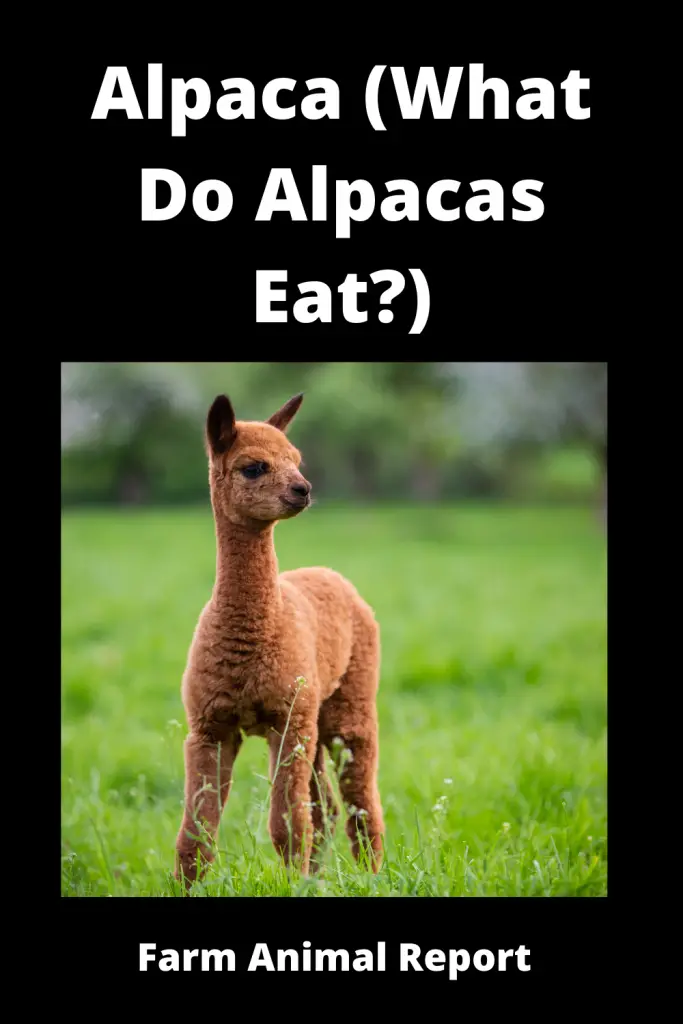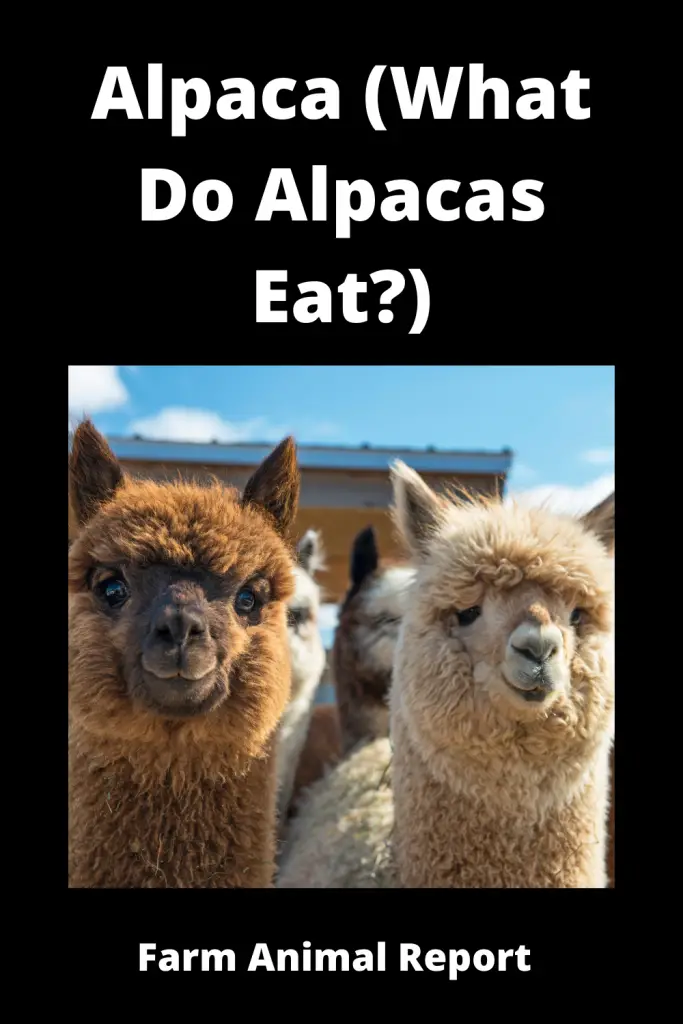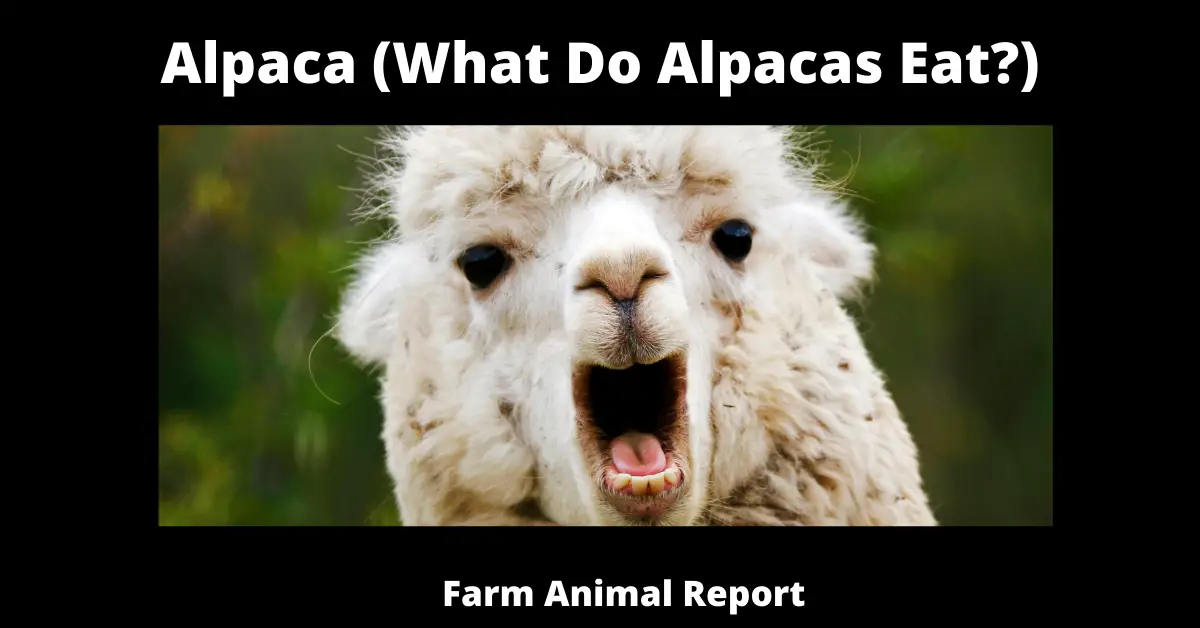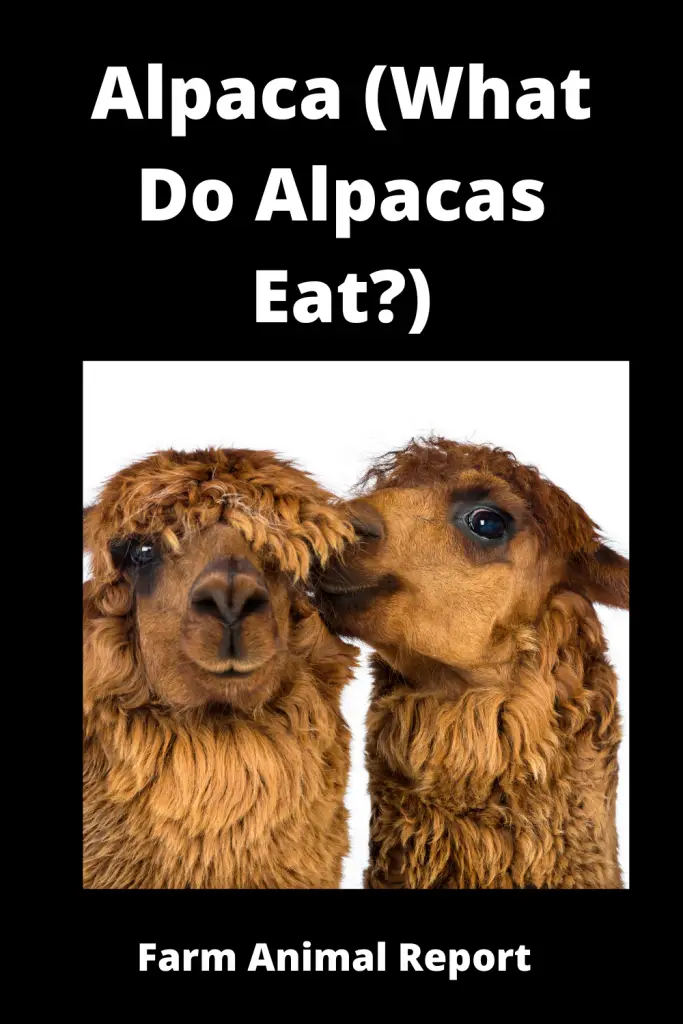As a general rule alpacas eat grass. Alpacas are herbivores, meaning they exclusively eat plants. They eat grass primarily, but leaves, wood, and stems can also be found in their diet. Alpacas, like other ruminants, have a three-chambered stomach that efficiently digests roughage.
What Do Alpacas Eat?
- Pasture
- Hay
- Pellets
- Supplements
- Minerals
- Vitamins
- Afalfa hay
- Bananas
- Apples — don’t forget to chop them into bite-sized pieces!
- Beet shreds – popular with pregnant and nursing alpacas.
- Stalks of broccoli (but NOT the broccoli)
- Chicory
- Carrots – best shredded.
- Clover — depending on what else is growing in the same area as the clover, not all sources agree that it is entirely safe. Although this one is listed, not every alpaca owner or expert believes it is always safe because of the caution. If you’re unsure, skip the clover.
- Mint leaves
- The dandelion
- Grains – all alpacas, but especially nursing and pregnant females, love grains. Just be cautious about the amounts and types of grain you use. Grain overconsumption is a real danger.
- Green beans (fresh is ideal; thawed, previously-frozen green beans are likely to offend alpacas)
- Salad greens (iceberg and romaine)
- Carrots
- Thyme
- Green radish
- Raisins
- Raspberries
- Turnips – according to some studies, small amounts of turnips are safe. It is classified as harmful by specific sources because large turnips may cause choking. Turnips should be handled with caution.
- Watermelons
- Yarrow
Check Out Amazon’s Educational Resources for Raising Alpacas
Also our Article on What Do Baby Alpacas Eat?
Alpaca’s Diet
The alpaca (Vicugna pacos) is a camelid mammal native to South America. It looks a lot like a llama. Wild alpacas, on the other hand, are often noticeably smaller than llamas. Both species are closely related and can crossbreed effectively. Both vicugna(Alpaca) and guanaco(Llama) are thought to have been domesticated from their wild cousins. The Suri alpaca and the Huacaya alpaca are two different kinds of Alpaca. What do Alpacas Eat?
Wild alpacas are raised in herds that graze at altitudes of 3,500 to 5,000 meters (11,000 to 16,000 feet) above sea level in the Andes of Southern Peru, Western Bolivia, Ecuador, and Northern Chile. Alpacas are much smaller than Llamas, and unlike llamas, they were bred primarily for their wool rather than as working animals. Alpaca fiber, like, sheeps wool is used to make knitted and weaved products. In South America, these items include blankets, sweaters, hats, gloves, scarves, a wide variety of textiles, and shawls; they include sweaters, socks, coats, and bedding in other world regions. According to classification, the fiber is available in more than 52 natural hues in Peru, 12 in Australia, and 16 in the United States.
What Do Alpacas Eat?
Alpacas are herbivores, meaning they exclusively eat plants. They eat grass primarily, but leaves, wood, and stems can also be found in their diet. Alpacas, like other ruminants, have a three-chambered stomach that efficiently digests roughage.
Alpacas, unlike other grazers, do not consume a large amount of food. According to the Alpaca Owners Association, a 125-pound (57-kg) alpaca only consumes about 2 pounds (907 grams) of food every day. Alpacas eat 1.6 percent of their body weight per day on average.
What Types of feed are best for my Alpaca?
What to feed alpacas – The Pasture, hay, concentrates, minerals, and water are all necessary components of an Alpaca’s diet. All of these forages are ideal for alpacas.
The following are some essential facts about these nutrients.
1. Pasture
Alpacas graze and browse in addition to grazing. That means they’ll eat while removing specific amounts of brush and undesired plants like blackberry and wild rose from your pastures. Alpacas browse, though not as well as llamas, and prefer (by far) soft grass. When adding a few alpacas to your hobby farm you may usually get by with current pastures, but if your ambitions surpass a few heads, talk to your county extension agent about pasture upgrades. The agent can advise you on grass and legume mixtures that grow well in your area, as well as how to oversee them in existing pastures. The agent will assist you if you need to start over from the beginning. Alpaca pastures are often sown with a variety of grasses as well as one or two legumes. Typical constituents include orchardgrass, timothy, fescue, white clover, and alfalfa. Keep in mind that some pasture forages require reseeding at regular intervals while others continue to flourish.
2. Hay
The best alpaca diets are high-fiber alpaca diets based on high-quality Pasture and hay. Long fiber grass hay is the ideal dry fodder. Too much high-protein hay, such as alfalfa, clover, lespedeza, and other legumes, might cause the same issues as too much high-protein concentrate. I address the necessary nutrition values in a separate section because hay is so crucial.
When giving hay to alpacas, keep in mind that they are picky eaters. They nibble on desirable grass and spit out less desirable morsels on the floor or ground, where they will be trampled. Feed hay from waste-resistant feeders to save money and time, and use discarded hay for bedding (or provide it to less picky species such as cattle and horses). Allow enough hay racks and feeder area for all of the Alpacas in the Group to eat happily together , including the shy ones.
Feeders should be kept clean. Most alpacas will not (and should not) eat or drink from dirty hayracks, feeders, or water sources for health reasons. This is especially crucial if your alpacas live with messier species like equines or cattle.
3. Pellets – Concentrates
Concentrates, such as grains and commercial feeds based on grains, ferment faster than forage, resulting in excess acid that can kill microorganisms and, eventually, the animal they feed. As a result, it’s critical to provide concentrates only when people are genuinely in need. According to nutritionists, late-gestation females require 1 percent of their whole body weight in grain, whereas breastfeeding females and developing children require 2 percent of total body weight.
Clean, mold-free commercial mixes (made by big firms like Mazuri, Agway, Blue Seal Feeds, Buckeye Feds, and Dynamite) or a grain mixture created expressly for your animal’s needs are your best bets if you feed concentrates. Make sure it’s out of reach of your llamas or alpacas and out of reach of birds, cats, mice, and other creatures who might contaminate it with their droppings.

Minerals and Water are vital to the Survival of Alpacas.
Minerals
Always use a high-quality, loose mineral mix made specifically for your alpacas and their environment. Use only alpaca-specific combinations because other species’ blends typically contain copper in proportions harmful to alpacas. (With the possible exception of no-copper sheep minerals, lama-specific goods should be your first pick.) Stillwater Minerals is an excellent supplier of minerals that we frequently use. On the other hand, our local ranch supply has recently started carrying alpaca and llama salt, which cuts down on costs and shipping. If your Alpacas live with another species, you must keep the other species’ minerals out of reach of your alpacas (i.e., alpacas should not lick horse salt blocks).
Water
Water is the cheapest and most vital nutrient of all. Every day, the average Alpaca drinks 5-8 percent of its body weight in water, and in hot weather or when breastfeeding, it needs 10-18 percent of its body weight. Alpacas cannot flourish without constant access to clean, good-tasting water throughout the year. They need it to keep their digestive systems healthy; certain males and geldings get urinary calculi if they don’t drink enough water; breastfeeding females need it to produce milk.
Don’t cut corners. Keep the tanks and bucks clean and complete. Consider installing automatic watering fixtures, but if you do, make sure to clean and inspect them daily to ensure that your alpacas have access to drinking water when they need it.
What types of Feed are not Suitable for my Alpaca?
Anything with molasses or grains should be avoided! Grains should only be given according to your veterinarian’s instructions. Concentrate-rich diets can cause a variety of significant health problems. If you’re supplementing grain, make sure you get llamas and alpacas pelleted commercial food.
What is best for Young Alpacas?
A combination of forage and clean, grass-type hay is ideal for young alpacas. Overfeeding or reliance on protein-rich grasses like alfalfa can be harmful. Orchardgrass, timothy, clover, and alfalfa are found in our pastures (no more than 20 percent ).
Apples, berries, broccoli stalks, carrots, pumpkin, raisins, turnips, and other safe-to-eat fruits, vegetables, and plants are also favorites of alpacas. Because this herbivorous animal only has lower teeth for tearing, and not eating, treats must be broken up or shredded to avoid choking.
What is Best to feed my Alpaca when Pregnant?
Alpacas in the growing stage and late-pregnant and lactating females will consume roughly 2-2.5 percent of their body weight in dry matter. Feed pleasant, digestible roughage to meet maintenance requirements (lush green Pasture, hay, silage). Then, as needed, supplement with energy/protein (high-quality lucerne hay/oats/lupins/peas).
Alpacas have a 350-day gestation cycle that is separated into three trimesters. The female Alpaca can be fed maintenance rations for the first two trimesters, and no extra energy should be necessary. She will, however, most certainly require a well-balanced diet rich in critical vitamins and minerals. A camelid vitamin and mineral supplement, also known as a balancer, requires very little extra energy and is an excellent approach to a well-balanced diet.
The third trimester is when most fetal growth happens, and this is also when the female’s energy requirements increase and during nursing. Traditional feeding recommendation would be to give up to 1kg of cereal per day, but a healthy option would be to use an Alfa-A feed instead.

Rationing advice
- Hay or grazing ad libitum
- 100–250g Alfa-A Original / Alfa-A Lite / Alfalfa Pellets per day
- Camelid balancer in the suggested amount
- The infant cria will initially rely on its mother’s milk for colostrum and sustenance once it is born. It will gradually begin to graze as it grows older, but it will take several months before it can effectively use grass as an energy source. At 4-6 months of age, the cria usually is weaned and requires a ration identical to the one mentioned above.
How Much Can I feed my Alpaca?
The nutrition requirements of camelids, especially alpacas, are mainly unclear due to a lack of studies. The majority of estimations are based on extrapolations for ruminant nutrient requirements, particularly for goats and sheep. Alpacas range in weight from 45 to 80 kilograms and can consume 1.8 to 2% of their body weight in the dry matter daily. This would translate to roughly 1.13kg-1.26kg dry matter per day for a 63kg alpaca. Alpacas have been designed to eat a fiber-based diet, and their digestive systems work best and are the healthiest when they do.
The most frequent feeding method for alpacas is grazing accompanied with supplementary hay, with additional cereal concentrate meals offered at periods of higher energy requirement, such as the winter months, pregnancy, and lactation. Although cereal concentrates give the extra calories required, they may induce digestive issues such as stomach ulcers, colic, and acidosis. Alfalfa, a high-fiber, low-starch alternative to cereals, is an excellent source of fiber.
What Types of Feed for my Alpaca in the Winter?
In the summer, llamas and alpacas graze on lush meadows, while in the winter, they are fed hay. When scratching, they’ll perform best on grass, with a bit of alfalfa thrown in for good measure. Llamas eat one bale of hay every week in the winter, whereas alpacas take roughly half a bale. You may need to supplement minerals in their diet on occasion.
In the winter, all alpacas will happily consume soaking beet pulp. It’s especially crucial to keep an eye on senior animals, whose fleece has a shorter staple length and provides less insulation against the cold. They may need to be coated. Another essential factor to consider in the winter is having access to a non-frozen source of water.
They should be out grazing (and enriching your land) if the weather is good and there is enough grass on the Pasture!
Young alpacas should eat grasses and leaves generally since they contain more nutrients and are easier to digest.
Do Alpaca eat Weeds?
When they run out of feedstuffs or nutritious grass, they might eat weed. They are “frugal feeders,” meaning they eat very little and may eat various weeds, trees, and grasses. Alpacas do not thrive in lush, fertile pastures and highlands areas which are ideal for them.
What types of Problems do Commercial Livestock feeds done to Alpacas?
Bloat in Alpacas can be caused by high-concentrate livestock feed. Llamas and alpacas should be fed a commercial pelleted feed intended for them. Choose a feeding formula based on your camelid’s life stage (i.e., growth, maintenance, etc.). To avoid obesity, feed according to the label’s instructions. Never give grain or pelleted meals to your animals on a free-choice basis. Supplemental meals for alpacas are available to boost Fiber quality.
What Kind of Treats is best for my Alpaca?
Alpacas are generally herbivores, although they enjoy treats as well. Raisins, pumpkins, iceberg lettuce, beets, bananas, pineapples, strawberries, and apples are some of the most fabulous goodies you can give them.
Don’t worry; that’s not an exhaustive list. The following is an alphabetical list of alpaca snacks. Just make sure they’re safe for your alpacas and that they’re bite-sized. Oh, and don’t overfeed your alpacas with treats.
- Alfalfa hay
- Bananas
- Apples — don’t forget to chop them into bite-sized pieces!
- Beet shreds – popular with pregnant and nursing alpacas.
- Stalks of broccoli (but NOT the broccoli)
- Chicory
- Carrots – best shredded.
- Clover — depending on what else is growing in the same area as the clover, not all sources agree that it is entirely safe. Although this one is listed, not every alpaca owner or expert believes it is always safe because of the caution. If you’re unsure, skip the clover.
- Mint leaves
- The dandelion
- Grains – all alpacas, but especially nursing and pregnant females, love grains. Just be cautious about the amounts and types of grain you use. Grain overconsumption is a real danger.
- Green beans (fresh is ideal; thawed, previously-frozen green beans are likely to offend alpacas)
- Salad greens (iceberg and romaine)
- Carrots
- Thyme
- Green radish
- Raisins
- Raspberries
- Turnips – according to some studies, small amounts of turnips are safe. It is classified as harmful by specific sources because large turnips may cause choking. Turnips should be handled with caution.
- Watermelons
- Yarrow
Treats aren’t part of their daily diet, so make sure any special treats aren’t something they consume every day. Alternatively, feel free to switch things up every day, so your alpacas have a daily treat without getting too much of one awesome thing.
Also, make sure you chop up any treats you give your alpacas into small pieces before feeding them to them. Because alpacas can’t chew their snacks, they need to be as small as possible to avoid choking. You should have no problems after you figure out the best bite-sized treats to feed alpacas.
Last but not least, emphasize alfalfa, shredded beet, and even calf manna treats when you want your Alpacas to Gain weight, such as when they’re young, pregnant, or nursing. Many alpaca ranches claim that calf manna is entirely safe for alpacas and that it aids in their weight loss.
To be safe, please consult your vet-doc before trying any new treats, especially if you want to raise Alpacas
What are the Best Vitamins / Nutritional Supplements for my Alpaca?
The bacteria that live in the fore-stomachs of Alpacas provide many water-soluble vitamins such as vitamins B and C. So, healthy alpacas do not require supplementation of these vitamins.
However, vitamins A and E are fat-soluble vitamins that can be found in green grass (even green weeds that emerge after a brief summer rain) and only require supplementation if Pasture is completely dry for more than 8-10 weeks.
Alpacas require only vitamin D supplementation. Inject 2000 IU vitamin D/kg body weight under the skin or into the muscle into all alpacas under the age of three and all females scheduled to give birth in the winter/early spring (to fortify colostrum). Late autumn to mid-winter is the best time to use it (and early spring in higher latitudes like Tasmania, New Zealand, Europe, Canada).
Read the label on the bottle to establish the vitamin D concentration and how much to take. For example, A 20 kg fetus requires 40,000 IU of vitamin D. If your chosen source of vitamin D contains 75,000 IU per mL, the cria will need around 0.5 mL of the solution to be injected. Vitamin D overdose can be dangerous.
Problems I can Have with Alpaca Feed?
There are many problems associated with Alpaca feed, such as:
- Expire pelleted diet
- Mold
- Toxin
- Excessive dry matter (leads to bloating)
- Less nutritional quantity and low-quality feed (In commercial feed)
Avoid feeding excessive supplements that can be expensive, time-consuming to provide, and toxic to camelids. Because horses and pigs have different digestive systems and mineral requirements, so do not feed Alpacas those supplements that are developed for horses and pigs. Avoid feeding pellets unless they are being used solely to deliver a specific supplement (e.g., zinc to help prevent facial dermatitis), as they are usually quickly digestible, lacking in fiber, and will cause acidosis and perhaps death.
Interesting information about Alpacas
- Alpacas are a South American breed that has been domesticated for a period of more than 5,000 years
- They belong to the Camelid family, which includes the following animals: Camels, guanacos, llamas, and vicunas are examples of these animals.
- Alpacas do not have cloven hooves; instead, their feet are flat that are cushioned, and they protect even the most delicate terrain.
- The Alpaca is a three-compartment ruminant with a modified ruminant stomach. It is particularly efficient at converting grass and hay into energy.
- Alpacas cut grass rather than tearing it out, and the grass soon regrows.
- The Alpaca’s camelid ancestry helps it survive without eating a lot of water; however, it requires freshwater.
- An alpaca herd concentrates its waste in one or two locations in the Pasture, limiting parasite spread.
- Alpaca dung is used for fuel by South American Indians. Gardeners find the Alpaca’s rich fertilizer ideal for growing fruits and vegetables – it can be used with or without other fertilizers.
- Soak dried “Alpaca Beans” (Poop!) in water to make a fantastic fertilizer “tea”!
- Alpacas do not require fancy barns; they only require minimal shelter from snow, wind, and rain when the weather is particularly harsh.
- Alpacas produce excellent fiber, which can be spun, woven, or knitted into luxuriously soft, allergy-free clothing. Durable rugs can be made with coarser fiber. Each year, an alpaca produces enough fleece to create several soft, warm sweaters.
- Body language is how alpacas communicate. Spitting is the most prevalent sign of anguish, anxiety, or a desire to assert control. Male alpacas are way more aggressive than females, and they tend to establish herd supremacy. To demonstrate their strength and authority, alpha males would sometimes immobilize the head and neck of a weaker or challenged male.
Final Thoughts
Alpacas consume approximately 2% of their body weight in feed per day. At all times, alpacas should be grass-fed. Alpacas thrive on native pastures, but they can also be supplemented with high-quality hay and grains. Alpacas can be harmed by perennial ryegrass poisoning, annual ryegrass toxicity (ARGT), or phalaris toxicity, just like other livestock.
Please consult your veterinarian for details on all diseases, their likelihood of incidence, and testing options. Alpacas must have constant access to fresh water. Each animal must be allowed to drink up to 4 liters per day.



